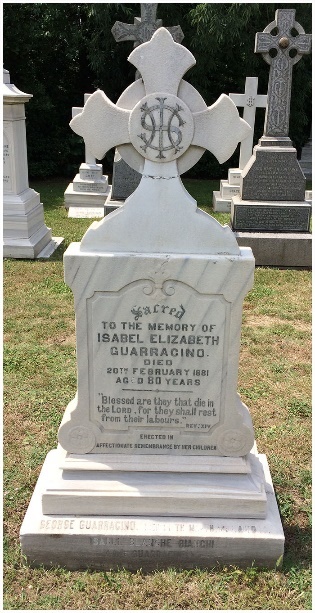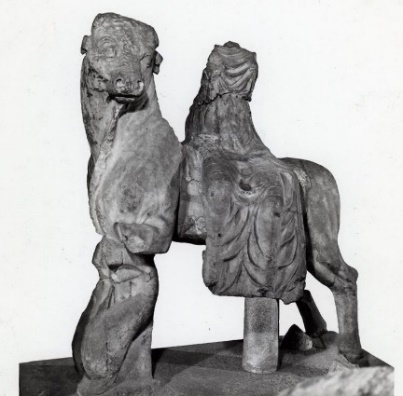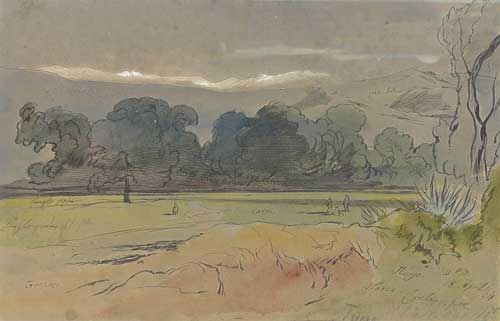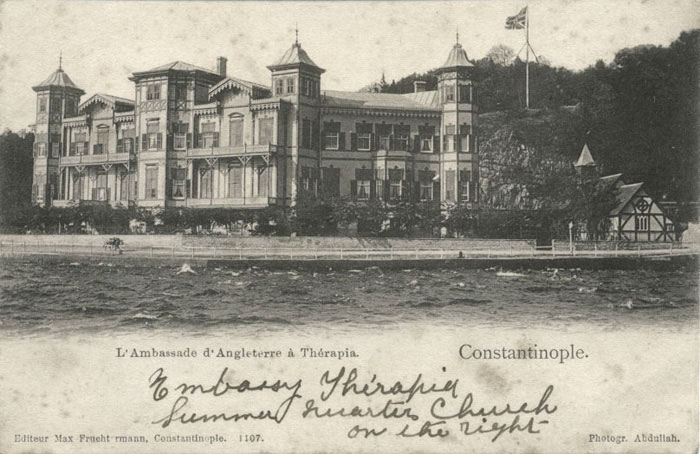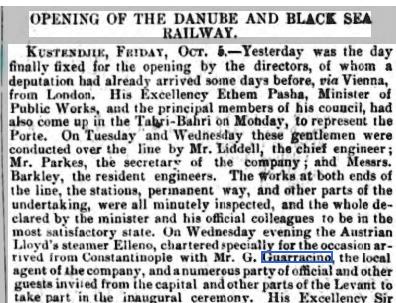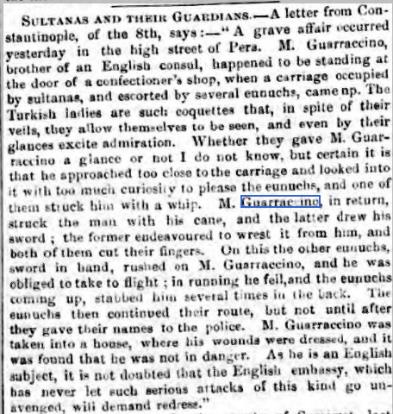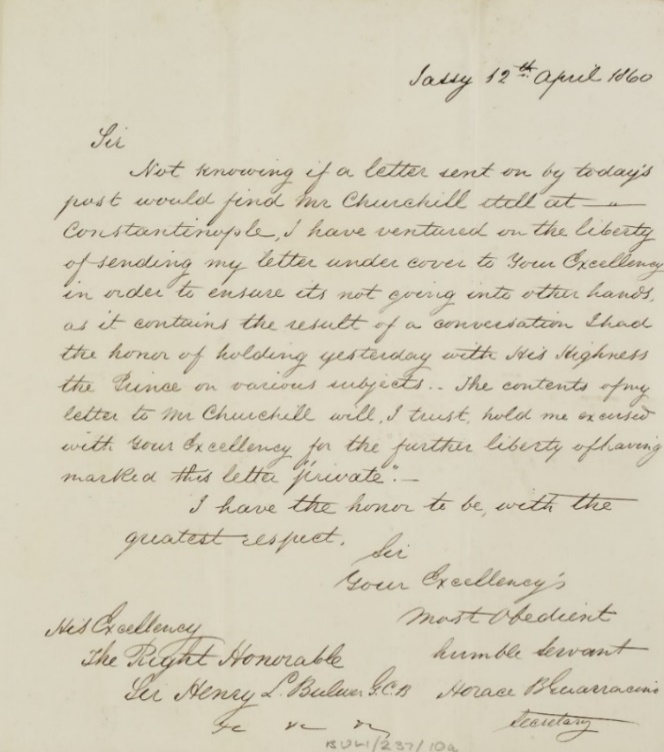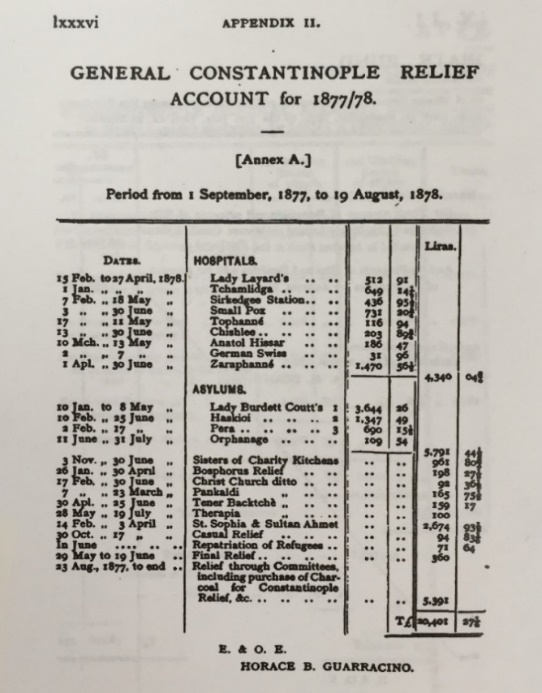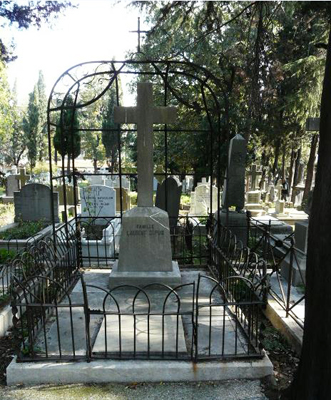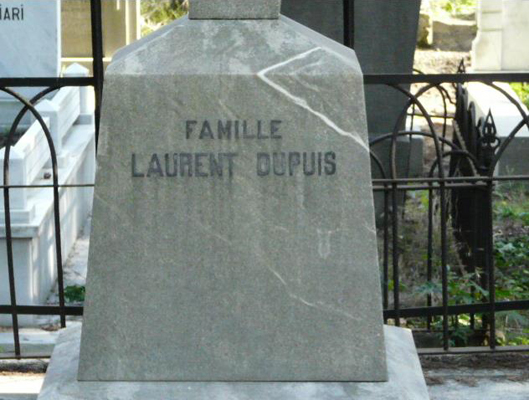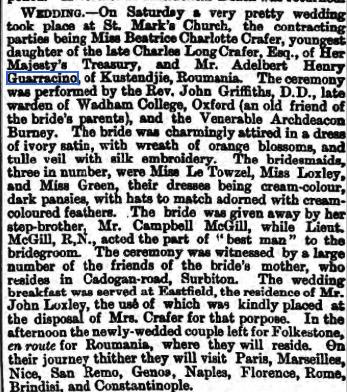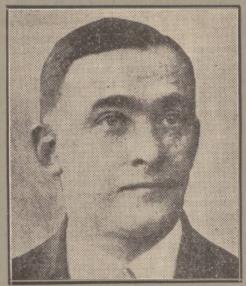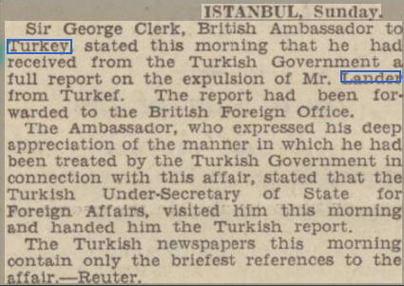
The Contributors
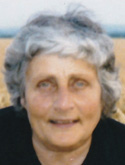
Recollections of Maud Guarracino (married name Hagan)- notes taken by her daughter Lucy Hoad from her direct account. 15th July 2012
It was reading Mary Lemma’s recollections on the Levantine Heritage Foundation that brought back many memories for me and I was persuaded to write some of my own. Mary Lemma mentioned myself and sister Daisy and our father Mr Guarracino in her account, remembering that I used to go to the English Girls High School with her and lived in the same little community of British Residents in Beyoğlu just behind the British Consulate in Aynalı Çesme Street.
Both my father, Frederick Guarracino and my mother Corrine, nee Caz, came from Levantine families. My father had British nationality through his father Horace Bronte Guarracino (my grandfather). My mother’s nationality was French through her father. Consular records / national archives, newspaper archives, books and numerous entries in Lady Layards diaries, detail the connection members of the Guarracino family had with the British Community; Consular Service in the Ottoman Empire; The Ottoman Regie; Trade and Commerce, going back to the early 19th Century in Malta, Ionian Islands, Turkish Black Sea ports and Constantinople.
Memories of growing up in Beyoğlu and Yeşilköy
I was born on 26th October 1925 in Beyoğlu, Istanbul.
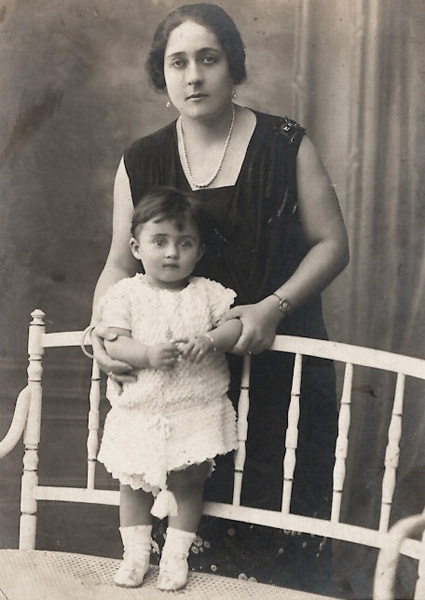
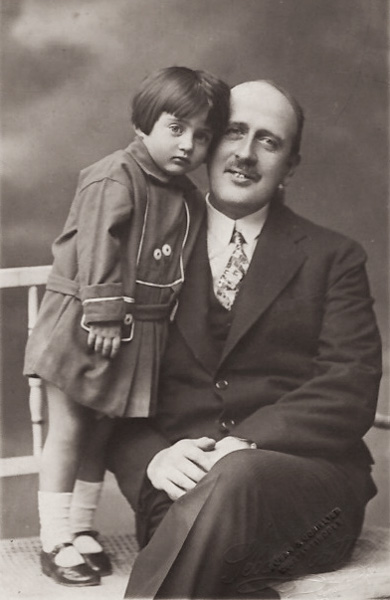
With my mother Corinne circa 1926. - With my father Frederick circa 1927. Family album
My older sister Yvonne, who had been at a convent boarding school in England, returned to live with us in 1926. She got a job with the Chamber of Commerce and made lots of friends; La Fountaine’s and the Christies.
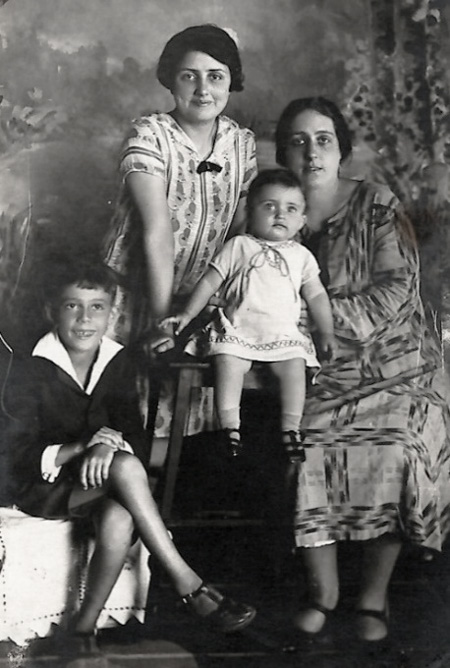
Left, Silvio (brother) 1, Yvonne (sister) 2, Corrine (mother), holding me. Istanbul 1926. Family album
My sister Daisy was born in 1929 in Beyoğlu, Istanbul. Shortly afterwards the family moved to Yeşilköy a country village on the coast (previously known as San Stefano, but changed in 1920 because of legislation to ensure a Turkish name was given to each community).
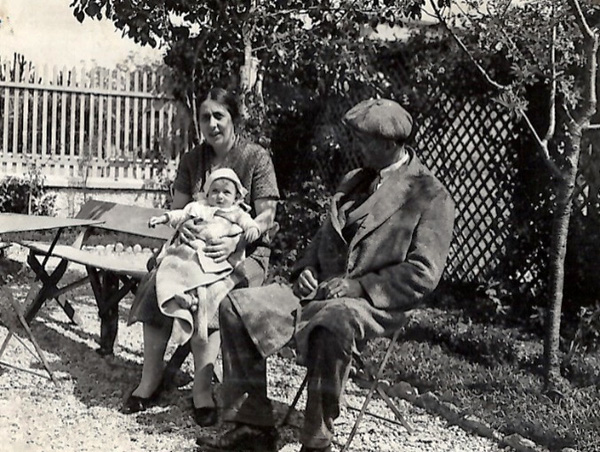
Daisy with mother and father. Yeşilköy 1930. Family album
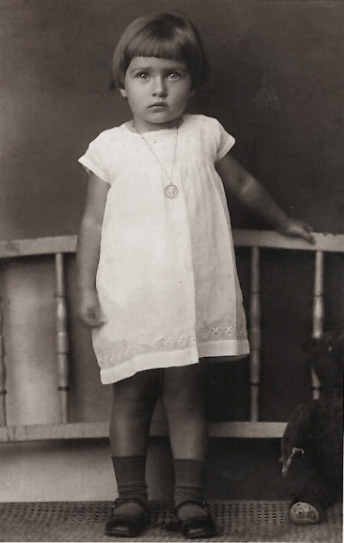
My sister Daisy. Circa 1933. Family album
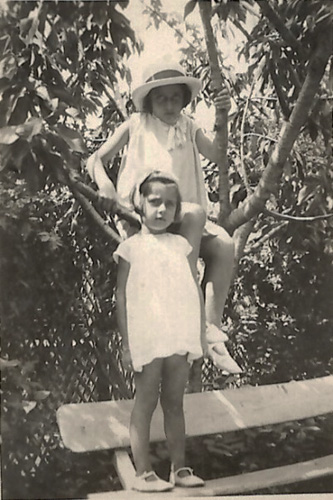
Sitting in the tree in our garden, with my sister Daisy standing. Yeşilköy. Family album
Our family returned to Beyoğlu in late 1930’s for easier access to the English Girls High School. We spoke French at home. I could speak fluent Greek, which we often used in shops. I also learnt English, as well as Italian and some Turkish.
Childhood in Yeşilköy
Some of my earliest and happiest memories are of my childhood growing up in Yeşilköy.
Houses. Like many of the other houses / villas, our house was detached with a balcony and terrace. It had a beautiful garden set amongst fig and cherry trees. I remember there being no direct water to the house. In the basement was ‘la cistern’, ‘the well’ which was dug when the house was built. A motor with fan belt brought the water up. All the laundry was also done in the basement, where there was a big grey slab stone sink for washing the clothes and a cauldron for boiling the water.
The house was fairly near to the station – convenient for my father, Frederick, to catch the train into town (Istanbul) where he ran his business as a Commission Agent. When we moved to Yeşilköy, my father bought his first car – I think, a Buick.
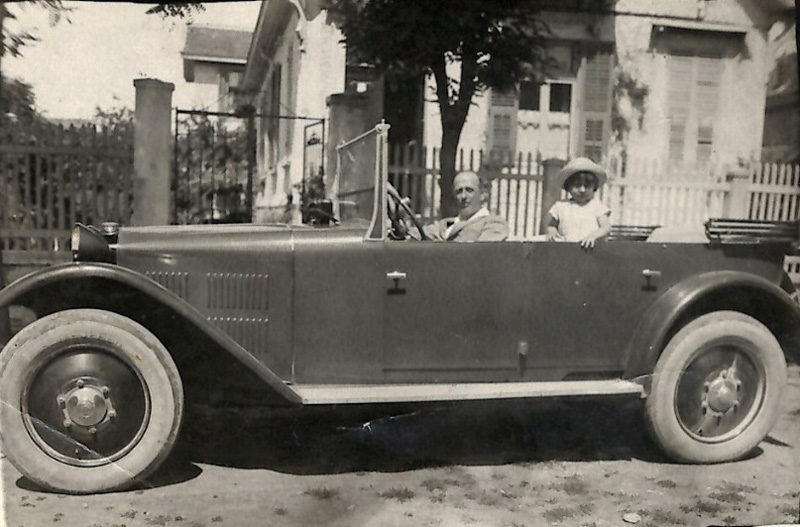
The photograph shows me with my father Frederick in his car outside our house in Yeşilköy 1930. Family album
Life with the Seasons. When I think of my childhood in Yeşilköy, I remember each season distinctly.
Winter - it was very cold and the snow lay deeply clinging to the rutted road.
Spring - the Acacia trees proclaimed the changing season. This was followed very quickly afterwards by summer.
Summer - the Camel’s brought the charcoal everyone used as fuel for cooking. I remember the camels resting in the fields nearby.
In the harbour there were always lots of small sailing boats and in summer the beaches and the sea were full of people. Another nice past-time in summer was to walk along the rough path leading to the Yeşilköy lighthouse. Nearby was a cafe where they would put music on and people would dance to the songs of Tino Rossi whilst the lighthouse pulsed out its white light.
On summer days there would also be outings to the vineyards with our friends the Bomoniti’s. We would hire one of the horse drawn carriages and each family would prepare a picnic; meat balls, stuffed vine leaves, aubergine salad, mezze salads – all packed in dishes, interleaved with white napkins placed in big oval baskets made of reeds. We headed out of the village under the railway bridge travelling over the dusty fields until we arrived at the vineyards where the picnic was laid out on the long wooden tables. The tables came free provided you bought iced beers and kilos of grapes which were laid out on the tables.
Other outings would be viewing days to the open field airstrip and wooden aeroplane hangar which housed a few planes (with double wings and a propeller on the front). It is now unrecognisable as it became Istanbul’s main airport. I would often go with my older brother Silvio who took me everywhere with him. He taught me to cycle and showed me how he caught birds.
My father enjoyed shooting game and kept dogs to retrieve the birds.
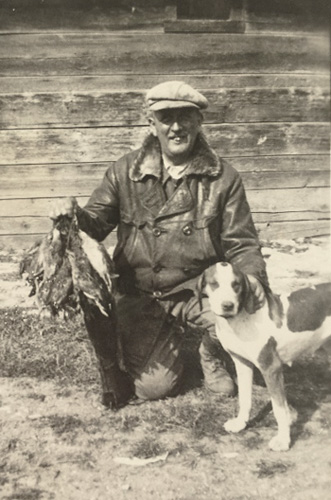
My father Frederick Guarracino. Yeşilköy. Family album
Autumn – we knew autumn was coming when we felt the warm mistral wind blowing off the sea and the sea became rough.
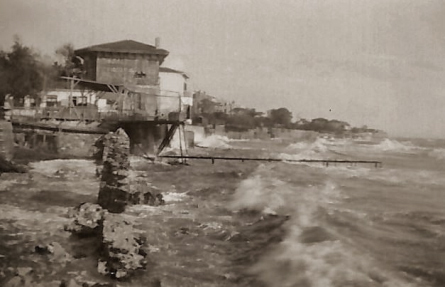
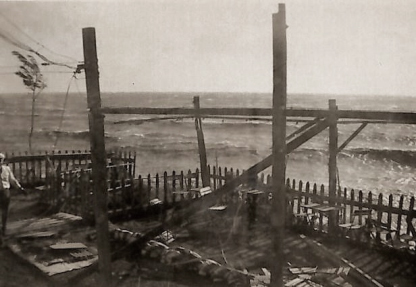
Yeşilköy beach in the Autumn. Family album
Neighbours, were mainly Italian, French, Yugoslavs, Armenians, Greeks, Jews. Most were professionals, doctors, lawyers, bankers and businessmen who worked in Istanbul. In the summer some of the wives would put on their best dresses and walk down the thoroughfare of Yeşilköy up to the station to meet their husbands returning home about 7.00pm. They might buy water melons from the street sellers along the way and their husbands would carry the melons home. Horse drawn carriages also used to wait for hire on the cobbled street to take home those who lived further away from the station.
At the back of the church were apartments next to the sea. Living there were our dear family friends Simone and Miquette Corinthe.
Shops & trades people in Yeşilköy. There were a few shops along the main village street; one Pharmacy, a Baker, who was Turkish; a Butcher who was Greek and a Grocer ‘Angelides’ who sold things like rice and dried beans.
Yeşilköy also had a small factory by the railway bridge. I remember the sign saying ‘His Masters Voice’ records.
Near the station was a Barber and next to him a very popular tea room, covered but with no doors. They sold a dessert a bit like profiteroles, called Zuppa Inglese and served lemonade freshly made with lemons. You could also buy another drink made with sour cherries.
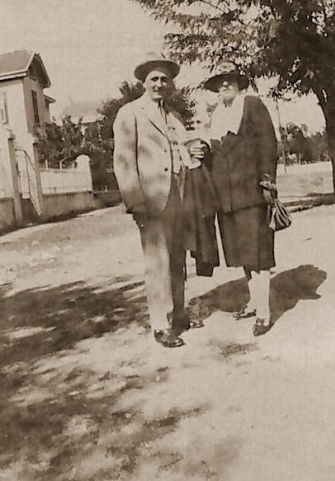
Yeşilköy. Mother and father going to the station to catch the train to Beyoğlu. Family album
The Turks in the village who worked as fishermen lived mainly towards the end of the bay - the headland. In summer, they would load their donkeys with baskets either side containing produce, runner beans, tomatoes etc and mother’s maid would run out to buy for them. There was also a piece of land at the end of the bay which had a machine on which was used to chop logs. The logs were essential for everyone as they were the only means of heating the houses and water.
Schools in Yeşilköy. The primary school in the village for the Turkish children was part of the Mosque. For the Christians, the Italian Nuns opened a very small, (one classroom) school near the Catholic Church, but it did not last long as children mainly went to the English girls ‘pre’ school attached to the High School in town. Children started school at seven years old.
King Edward VIII visits Istanbul.
In 1936 the family received a letter from the British Consulate inviting British children to meet King Edward VIII when he landed at the port during his cruise in the Mediterranean on September 6th. I remember waiting for him on the Jetty of the British Yachting club at Moda where he shook hands with them. A launch brought him, but not Mrs Simpson. We were all aware however that she had stayed on board the royal yacht.
Making my confirmation.
Apostolic Nuncio - Angelo Giuseppe Roncalli was appointed Apostolic Delegate to Turkey & Greece in 1935. Soon afterwards in 1936 I was confirmed by him at the French Cathedral of St Esprit, Istanbul. I remember him as a big man who sat on a throne. It was to be a great honour for in 1958 he became Pope John XXIII.
Returning to Beyoğlu.
In 1938/39 we moved back into ‘town’ (Istanbul) because getting to school was difficult. Many other families did the same only returning to Yeşilköy for the summer months to escape the heat of the city. We lived in large apartment in Aynalı Çesme Street. Our flats were all occupied by Christian families. The Concierge was a Turkish man from Anatolia.
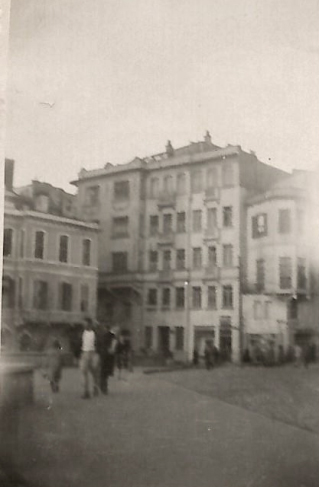
Aynalı Çesme Street. Istanbul circa 1940. Family album
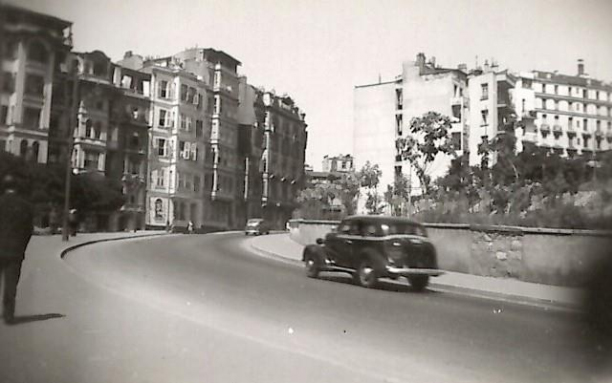
Aynalı Çesme Street. Istanbul circa 1940. Family album
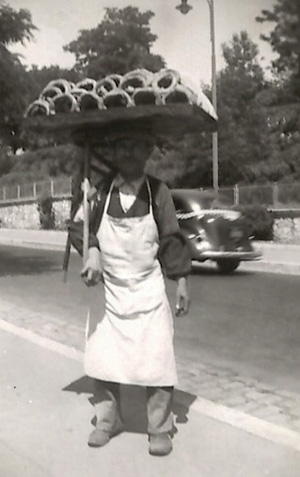
Sesame Bread ring street seller. Istanbul. Family album
Neighbours and friends in Beyoğlu.
In the same apartment block, next door flat, lived Cousin Hilda. I remember her with great affection. She was my father’s Uncle Frederick’s grand-daughter and first cousin once removed to my father.
My mother had close friends Marie Louise Serpos and Madam Comnino who worked at the Ottoman Bank. They had a small bungalow on the hill in Kandilli (on the Asiatic side) overlooking the Bosphoros. It was built on land that belonged to a great big Turkish house. Everyone enjoyed visiting them especially cousin Hilda who loved going on Sunday.
To get there you had to get the big ferry near the Galata Bridge. The ferry zig zagged across the Bosphoros from the European to the Asiatic side. You could swim in Kandilli but it was very deep.
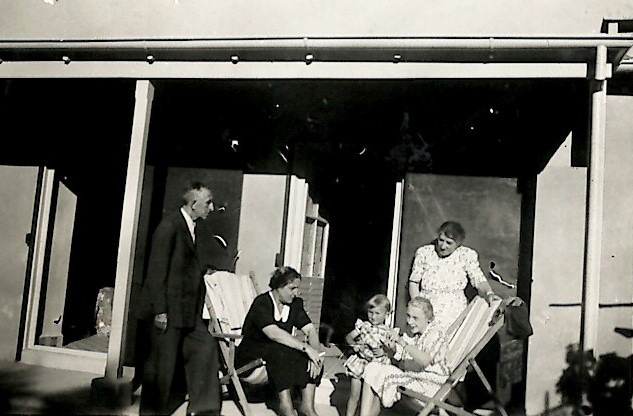
Mother left, seated in deckchair, visiting friends with Count Isidore Antoine Stanislas CZAIKOWSKI,left standing, right, Hilda Maria Luisa Beatrix CZAIKOWSKI nee SEEFELDER, seated in deckchair, with child and friend, standing. Family album
Friends from the English High School for Girls
Of the English girls I was friendly with I remember: Patricia Jackson, Lillian Fabri who had a sister called Doris, Daisy Moore, Gwen Bond, Lydia. I also remember Joyce Ritso.
Patricia Jackson was in the same class as me. She lived in a flat just off Taksim Square where we went to visit her. Patricia listened to the world forces radio and was able to pick up songs the forces listened to. She used to bring copies of the words to the songs I remember Vera Lynn; “I’ll be seeing you” and “The white cliffs of Dover”.
Lydia was one of my close friends and a Maltese English. One day during the war she suddenly came to see me to say goodbye. She said the British Consulate were evacuating their family to India. I never saw her again but kept in touch for a short while by letter. Lydia settled and married in India.
Gwen Bond had the idea to start up the Girl Guides. The uniforms came through the diplomatic bag and meetings were held at the British Embassy. A mixture of English and French girls went; all mainly attended the English High School. In the photograph (taken in the Embassy grounds), the French guides are dressed in white shirts.
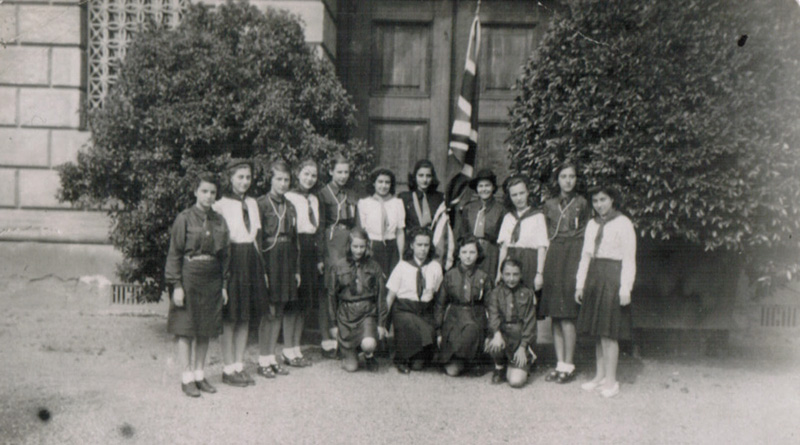
Family Album; From left to right: standing
1) Joyce Ritso 2) Miquette Corinthi 3)? 4)? 5)? 6)? 7) Maud Guarracino 8)? 9) Daisy Guarracino 10)? 11) Simone Corinthi
From left to right; kneeling
1)? 2) Ida Tunda (had a sister called Yola) Her mother was a seamstress who used to come and sew for our family for 3 to 4 days at a time 3) Daisy Moore 4) Dulcie – relative of Joyce Ritso.
Gwen Bond went on to marry an Englishman she met in Istanbul during the war called Lesley Johnson. They moved to live in England. I visited her in summer 1982 when she was living near Berkhampstead in Hertfordshire.
War years
During the Second World War the British Embassy played an important role in our lives. Ladies like my mother went there to sew parcels for prisoners of war. They also showed English films and we used to buy tickets. On the King’s official birthday, they always had a garden party to which we were invited.My father continued to work as a Commission Agent throughout the war, but it was understandably difficult due to the nature of the business.
Mail came by sea from England. Everything was censored. Letters were photographed. Dad used to get a copy of the photograph and then had to go to the main post office to a box to collect it. His office was near the Galata Bridge.
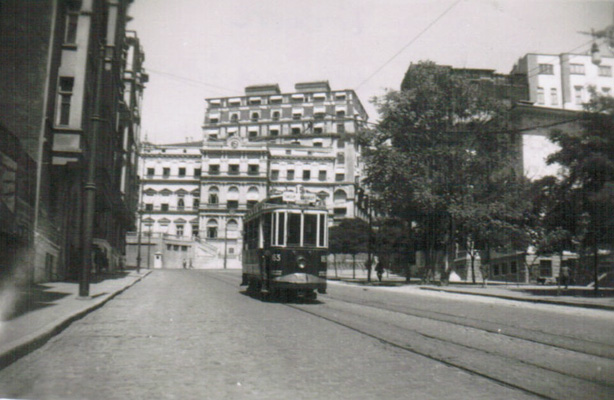
Tram coming up the hill from the Galatta Bridge, Istanbul –circa 1940. Family album
Beyoğlu district
In the main street of Beyoğlu - Istiklal Street (or as I remember it in Turkish: İstiklâl Caddesi) there was a beautiful flower market that led to the fish market as well as other fruit and vegetable and delicatessen shops. The delicatessen shops were mainly run by Germans or Swiss people. Whilst you shopped young boys with baskets on their shoulders waited to be hired to carry shopping. After work Father used to go to the delicatessen and markets and put the shopping in the boy’s baskets and they would carry it home and then be paid.
From memory there used to be four cinema’s on İstiklâl Caddesi. Every Friday Father took us to see a film he thought suitable for teenage girls. Afterwards we used to go to the Turkish pastry shop. On Saturday I often used to go again secretly with my friend Lydia to see a Romance.
White Russians
As part of my childhood recollections I remember the White Russians fleeing into Istanbul. Some opened restaurants / tea rooms in Beyoğlu. Another, (a lady) opened a gymnastic centre. I must have been about 7 or 8 years and still living in Yeşilköy when I was taken to it. Other White Russians gave English lessons, two of whom came to teach me. We spoke French at home.
When I was 15 / 16 I was asked by Miss Thompson, Headmistress of the English High School for girls, to help the daughter of a White Russian family to learn English. They had been helped by the British Consulate to find accommodation and were later evacuated to Australia.
Leaving Istanbul.
I often wondered why my father stayed in Turkey when his mother and 3 of his 4 sisters, Mary Tristram, Edla Tristram (2 sisters married 2 brothers) and Alice Vere, left just before the start of WW 1 to come to England with their families? I can only imagine it was because he had his own business and family in Istanbul. His other sister Daisy, married a Spanish Diplomat Pablo Soler (Soler y Guardiola). Father’s brother Alfred went to live and work in France as a Commission Agent before I was born. His daughter Madeline married into the Guerlain (perfume) family.
My paternal grandmother Clementine (nee Dupuis) lived in Kingston Upon Thames with Edla and family. I visited her a few times when I was in England in 1938. She died in Abingdon, where her grand-daughter Phyllis lived, in 1941 aged 96.
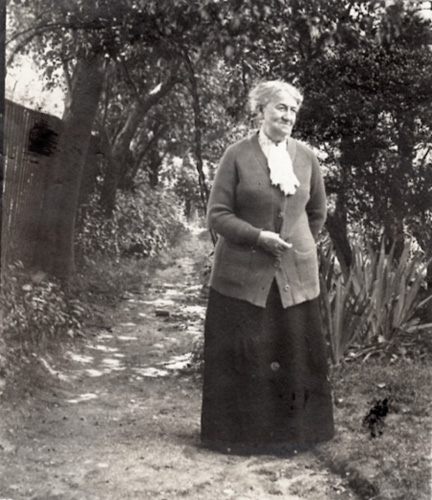
Clementine Guarracino, wife of Horace Bronte Guarracino, in the garden – Kingston Upon Thames. Family Album
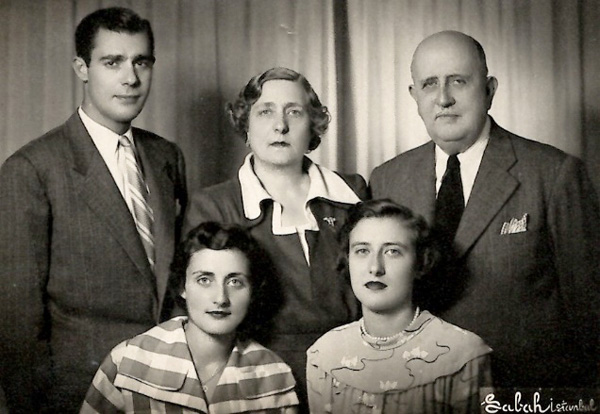
Family Album; front from left, Maud, Daisy. Back from left, Silvio Badetti (brother), Mother (Corinne), Father (Frederick).
I left Turkey in September 1946 and came by boat from Istanbul to Liverpool, England.
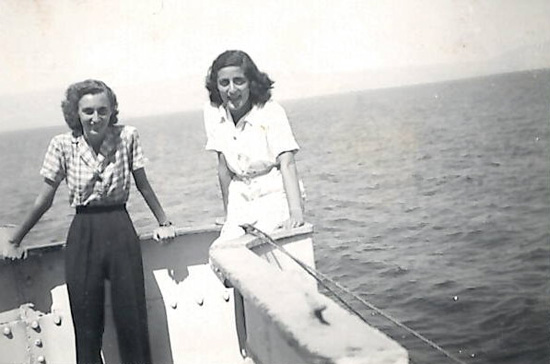
On board ship. Left Pat La Fontaine, right Maud Guarracino, 1946. Family Album.
I remember the crew had to look out to sea to check there were no left over mines floating, from the war.
I have remained living in England where I met my husband and brought up three children.
My sister Yvonne left for England just before the war in 1940 to marry Ron Adams whom she met in Istanbul whilst he was teaching at the English Boys High School. My sister Daisy left Istanbul in 1950 and came to London before working for Shell Oil in Saigon and Vietnam, finally settling in Heyrieux, France with her French Vietnamese husband and children. My parents remained in Istanbul; father died in 1967 and my mother in 1973. They are buried in the main Catholic Cemetery, Istanbul. My brother, Silvio took over my fathers business as Commission Agent and remained in Turkey until he retired with his wife to live near my sister and her family in Heyrieux, France in the early 1980’s.
Although my last visit to Istanbul was in 1967 just before my father died, my memories of Turkey are still very alive in my mind, together with those of the rich and diverse community I lived amongst.
Post script: Maud Guarracino, died 6 April 2013, aged 87 years.
1 Silvio Badetti, son of Corrine from her 1st marriage to Edmund Badetti 
2 Yvonne Guarracino, daughter of Frederick from his first marriage to Anais Penelope Savoides 
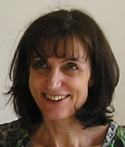
Guarracino Family
Our Levantine Ancestors
by Lucy Hoad, daughter of Maud.
Maud Guarracino our mother was a Levantine, born and brought up in Istanbul. Whilst she left Turkey soon after the second World War, her heart remained with her memories, people and streets of Beyolu and Yeşilköy. She wanted to understand more about how the family came to be in Turkey and about Hilda, a cousin whom she loved. Hilda lived in the next-door flat in Aynalı Çesme Street, Istanbul.
We started together by contacting and visiting cousins still alive in the 1980’s. With this information and other sources recorded, this is the history I have gathered so far of the Guarracino family and relatives in the Levant. I was really pleased to be able to tell Maud much of it before she died in 2013.
So how did the Guarracino family come to be in Turkey?
The family had connections with the British Consular Service in the Ottoman Empire, Ottoman Regie, trade and commerce, going back to the early 19th Century in Malta, Ionian Islands, Turkish Black Sea ports and Constantinople. My research into records from National Archives and British Library Newspapers, revealed that the Guarracino’s had a rich history of connections with other Levantine families and consulates.
The history starts with Dominico Guarracino and Isabella Suter and follows three further generations through the lives of their four sons, Frederick, George, Horace Bronte and Adelbert Henry, their children and grandchildren.
First Generation: Dominico Guarracino and Isabella Suter
Dominico 3 was an Italian merchant on the island of Corfu 4. He came from Naples 5. According to a family letter the Guarracino’s were originally Spanish but moved to Italy to fight a war, and took Neopolitan nationality. As a reward for distinguished service, they were given the ‘Palazzo Guarracino’ on the island of Procida in the Bay of Naples. The ‘Guarracino’ family were one of the ‘Grande Families of Procida’ at the time. Many moved from the small island to Naples for employment. Guarracino was originally spelt with a ‘Q’ in Spanish and changed to a ‘G’ later on when the family were Neopolitan 6.
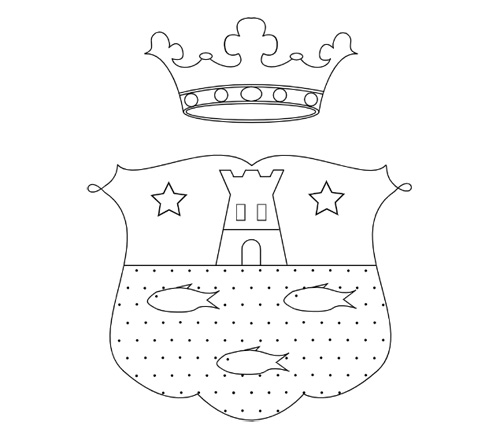
Guarracino Family Coat of Arms. 7
Guarracino is apparently the name of a small fish.
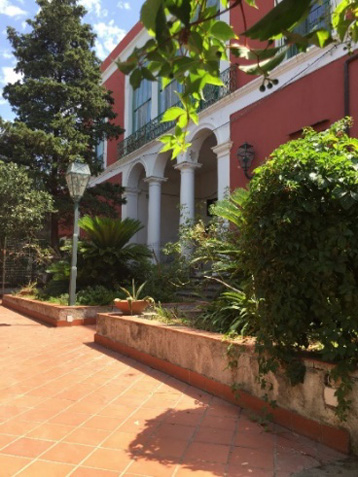
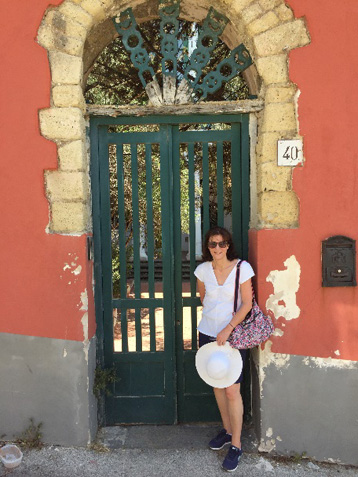
Palazzo Guarracino Procida - after restoration, August 2019 8
1822 Dominico Guarracino was described as a trader / shop keeper on the island of Corfu, along with Mr Suter, in a case where they were trading with Constantinople and sought compensation for the loss of a ship 9.
In 1827 Dominico was appointed British Consul General of the Ionian Islands 10.

He died in Bari where he was Honorary Consul 11.
Little is known about the rest of Dominico’s family except he had a brother Gennaro, who, had three sons, Constantino, Gennaro, Alexandro 12.
Dominico married Isabella Eliza Suter on Corfu, 29th August 1818 13. Presumably she was a relative of ‘Mr Sutor’. Isabella was a British Subject by birth. Born on the Island of Malta circa 1800. She died, 20th February 1881 aged 80 years, Constantinople.
Isabella was the daughter of George (d.1813, Malta) and Marianne Suter. George came from Dawlish, Devon, England 14. He had been a Captain in the Royal Navy as recorded in the Heraldry records of Isabellas’ sister Eliza, who married Peter Clark 15.
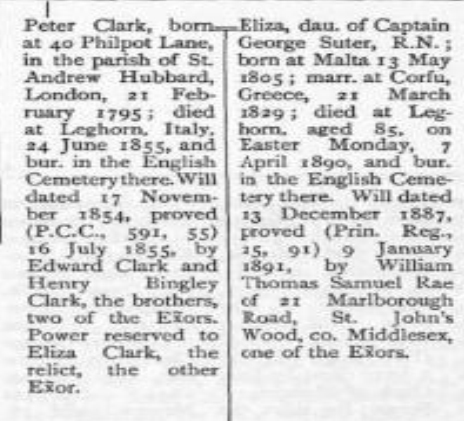
George lived with his wife Marianne in Valetta and had property in Salina. At some point George Suter left the navy and became a Public Auctioneer who sold captured ships, i.e. “Prizes” on Malta 16 17 18.
Isabella’s brothers, Horatio Bronte Suter (died, 12 May 1864 Varna) and Henry Suter (born 1803, died 8 May 1864) 19 were British Consuls in the Levant and remained so throughout their careers. Worthy of mention to illustrate the complex family connections of the Sutor’s is a list published by the Foreign Office:
“When Horatio’s son, Henry (Harry) Charles Nelson Suter, and his wife were kidnapped by brigands in 1881, the Foreign Office published a list of their relations “who are or have been in service of HM’s government:
George Stevens C at St Thomas (uncle); Thomas Wood C at Patras (uncle), George Suter VC at Keres (Jerez) (uncle), Kirby Green CG at Scutari (cousin german), Henry Suter late VC at Larissa retd (uncle), Frederic Guarracino C in Crete retd (uncle of Mrs Suter & cousin of Mr Suter); “parents and relatives deceased”: Horatio Bronte Suter Consul at Varna (father of Mr Suter), Richard White Stevens Consul at Tehran (father of Mrs Suter), Frank Stevens Consul at Trebizond (uncle of Mrs Suter). [Parliamentary Papers, Turkey No. 11 (1881)]
Harry Suter was a mining engineer who was prospecting for Mr F. Charnaud of Salonica” [The Times 21 Apr 1881]:
The family were connected by ‘a complicated network of family relationships extending over several generations, to other British Consular Officials in the Ottoman Empire and its former territories, from the sixteenth century to about 1860” 20.
Isabella was about 17 – 18 years old when she married in 1818. Her sisters Margaret 21, Anne 22, and Eliza 23 also married on the island of Corfu 24, suggesting they all moved there, perhaps after their father died in 1813 25. A family letter indicates that at some point Isabella ‘finding her husband too lavish with money went to Corfu to inspect British Schools in the Ionian Islands which belonged to Great Britain; but remained in touch with her husband until his death’ 26.
Final years: Isabella lived the final years of her life in Constantinople amongst the high society of diplomatic and consular circles. On ‘Tuesday. 29th [May 1877] at Therapia Istanbul, she is mentioned in the diaries of Lady Layard (English Ambassador’s wife) along with Mrs Baring, Isabella’s grand-daughter, by her first son Frederick) 27.
‘Finished my first sketch of gateway in the morning– At 4 Henry rode with Mr Kennedy & I went out walking. Went to the Hotel Petala to Mrs Barings room to pay a visit to Mrs Baker and afterwards we went on to Mme Parnis & found her in—to Mme Kalergi, Mrs Sorell, Mme Mavrocordato & old Mrs Guarracino who were all at home’ 28.
Isabella died in Pera, Constantinople, 20th February 1881, aged 80 years old 29. She is interned in Haidar Pasha Cemetery, Istanbul. All of her four sons and families were living in Constantinople at the time.
Second Generation: Children of Dominico and Isabella
Dominico and Isabella had four sons:
- Frederick Guarracino, born 19 August 1819 Corfu; died 11 November 1889, Malta, aged 70
- George Guarracino, born about 1826 Corfu; died 18 March 1896, Pera, Constantinople, aged 70
- Horace Bronte Carolo Luigi Guarracino, born about 1828 Corfu; died 24 March 1898, Galata, Constantinople, aged 70
- Adelbert Henry (known as Henry / Harry) Guarracino, born about 1845 Kephalonia; died 26 December 1903, England, aged 58.
Through family letters it was thought the four brothers were all British subjects, through descent from their English mother who brought them to England to live and be educated. At 21 years it was said they had a choice whether to take British or Italian nationality. Having been born to an English mother on the Ionian Islands (under British Protectorate) and educated in England, they chose to be British 31.
This was indeed true for Frederick, George and Horace, but not Adelbert Henry, who was born 26 years after his eldest brother. He had Italian nationality after his father. This only came to light very recently, when I applied for early release of Nationality and Naturalisation papers, of Beatrice Guarracino (wife of Adelbert Henry) held by the National Archives, Kew, England.

All four sons spent a great deal of their adult lives in Turkey / Constantinople. They came at the start of their diplomatic / business careers in their late teens and twenties.
First born son, Frederick Guarracino: born 19th August 1819 Corfu, Gentleman, died 11th November 1889. Buried, Ta’Braxia Cemetery Malta.
He was described as a ‘seasoned Levantine, who spent most of his life in the East’ 33 and was remembered fondly in ‘Memoirs by Henri Stephan de Blowitz’ 34.
‘Mr Guarracino, too, an Englishman, who had been in Constantinople almost all his life and who used to be a member of the English Consulate, a very active and intelligent man, who was liked by the Mussulmans and a great favourite everywhere’.
Frederick gave a lifetime of work to the British Consular Service in the Levant. For many years he was a Vice Consul and Consul around the Black Sea, before moving to Crete and then Constantinople as First Vice Consul / Acting Consul General.
Fredericks Consular career: 10 Nov 1840, aged 21 Frederick was first appointed Vice Consul at Batum (Batoom), where he spent 5 years 35. His post was under the jurisdiction of Mr James Brant Consul at Erzerzoom. As part of his duties, he was asked to prepare a report for dispatch to Lord Aberdeen British Foreign Secretary, in response to the memorial on the Anti Slavery convention, November 1841. In this Frederick states there is a very active slave trade in Batoom carried on by slave merchants who buy Georgian children from their parents and sell them in Turkey. He notes no British Subject or European had anything to do with it and it would cease if the Turkish authorities co-operated with the Russians who wanted to put a stop to it 36.
In 1845, Frederick made an excursion from Batum to Artvin, communicated by Mr Consul James Brant who was attempting to open up trading routes with Persia. His notes are still held by the Royal Geographical Society England, and provide a wonderfully intimate portrait of the countryside, terrain, villages, people, as well as trading opportunities 37.
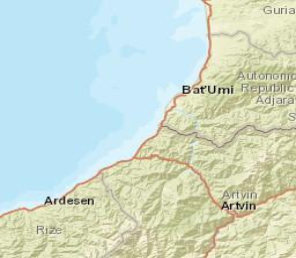
‘The valley of the Joruk, as far as I explored it, does not afford important resources for trade, as the people are generally poor, and the country unproductive. It is all too mountainous to supply cattel or to produce grain for exportation; and the only export beyond the insignificant articles mentioned might be for timber for which the Joruk offers a great facility; but this branch is neglected’.
March 1846 – 1859, Frederick was appointed Vice Consul and then Consul (1855) at Samsoon. Frederick stayed in the ‘swamps of Samsoon’ until he became acting chief dragoman Supreme Consular Court Constantinople 1859. During this time, he is also a Consul in Constantinople 38.
Frederick was next appointed Her Majesty’s Consul on the Island of Crete, July 1st 1860 39. He took up his position at a difficult time, following The Cretan Crisis of 1858 and in the twilight of Ottoman Rule 40.
Whilst Consul on Crete, Frederick played a key role in obtaining antiquities, ‘Europa and the Bull’, for the British Museum.
The Malta Times 1862 reports:
“H.M. steam corvett ‘Scourge’, Commander the Hon. W.J. Ward, which left Malta on Jan. 8, conveys to England, for delivery to the British Museum some pieces of ancient marble sculpture, obtained by the British Consul at Crete, Mr Guarracino and removed from the village of Metropolis, formerly a town, (one of the hundred for which in olden times famous,) built on the site of the ancient Gortinea or Gortyna” 41.
Frederick remained in Crete for two years, living in a country house near Canea in Halepa (Khalleppa), where his son was born 1862 43. Whilst Frederick left for Constantinople in 1862 to take up his position as First Vice Consul in Constantinople, it seems he kept his summer house in Canea, Crete, as Edward Lear (English artist, illustrator, musician, author and poet), visited and painted there in 1864.
1862 – 1872, Frederick was appointed First Vice Consul, Constantinople 45 46. 1867 he is listed as one of three Consul General’s (Francis, Guarracino, Logie), Constantinople 47. He listed as Consul General and Acting Consul General Constantinople in 1870 48.
Whilst Frederick was a consul in Constantinople there are records of him being commended for his compassionate work and organisational skills:
In August 1865 during a cholera epidemic Frederick was a leading figure in organising relief efforts for the sick and dying:
‘Cholera in Constantinople continued to rage; businesses were suspended; shops closed; bakers refusing to bake bread; poor left to sicken and die without help; richer residents formed sanitary committees whose only efforts were to establish cordons around their neighbourhoods to keep infection out. In contrast Frederick Guarracino played a key role in burying the poor and disinfecting houses’ 49.
1867, Frederick was put in charge of the building contract of the Consulate’s new Summer Residence along the waterfront in Therapia. The new building was occupied in May 1870. William Crossman, who visited the building soon afterwards, thought highly of it: ‘The arrangement … is excellent, nothing could be better’ 50.
The summer residence from the sea
The summer residence burned down on 13 December 1911 and never rebuilt.
Post retirement from HM Consular Service in May 1872, (after 32 years), Frederick was appointed in May 1872 as Superintendent of the Preventative Police, to prevent smuggling under the new ‘regie system’ 52.
October 1872, Frederick was appointed Controller in Chief of the new Tobacco Regie, ‘which became an Empire in itself, with a whole system of state machinery at its service’ 53.
Colonial affairs: 1876 -1878, were spent in some controversy for Frederick in Bulgaria and Cyprus, alongside his son in law Walter Baring (brother of Lord Cromer), who was HM British Secretary to Constantinople and influential lawyer. Their relationship it was said, demonstrated ‘the intimate connections between the main actors involved in the colonial affairs of Victorian England’ 54.
In 1876 Walter Baring had asked Frederick to accompany him to Bulgaria as an interpreter whilst investigating Turkish atrocities. The press made an accusation that both men played down the atrocities to prevent the rise of anti-Turkish sentiment in Britain.
In 1878 Frederick again accompanied Walter Baring who was overseeing the administration of the British Protectorate in Cyprus. As soon as Admiral Lord John Hay, Guarracino’s ‘old acquaintance’ took over the island on behalf of the queen, he named Frederick ‘Assistant Secretary to the Government at a salary of £60 a month’ 55. For a variety of reasons cited in the press (salary too low, too sick, not offered position in the first place) Frederick did not take up the position.
Frederick’s involvement in High Society – Constantinople: Soon after being appointed Vice Consul in Constantinople, Frederick was involved in horse racing at the Ottoman Court and was part of setting up a Jockey Club in Constantinople in 1863 56. He also owned a race horse called Jeannot, which clearly did well, winning several races 57.
A few years later in 1869 he was part of the organising committee for the Prinkipo Regattas 58 59.
On 9th February 1880, dressed as the ‘King of Lahore in a brilliant array of gold cloth, green satin and gems’ Frederick was a guest amongst 200 English, French, Persian Ambassadors and other prestigious guests, at a sensational fancy dress ball in Constantinople (first of its kind) held by Admiral Hobart Pasha and his wife the Hon. Mrs Hobart Hampden 60.
Frederick married on 7th December 1846, Elena (Ellen) Georgiana Stevens, the daughter of Notary William Stevens (Malta) at the consulate in Trebizond, where her brother Francis Stevens was Consul 61. Her father had taken her and a sister to visit her brother. They remained there after he left and acted as hostesses for their brother.
‘Arriving at the house of Mr. Stevens, he and his two very amiable sisters received me with the greatest cordiality and a room was prepared for me’ 62.
Francis along with his brothers Richard and George were all consuls in Turkey. Consular correspondence with Viscount Palmerston and others in the National Archives lists Suter, Guarracino and Stevens often within the same data set 63. In 1841 Suter is Vice Consul of Trebizond, Richard Stevens Vice Consul in Samsoon and Frederick Vice Consul in Batoon, all under the jurisdiction of Consul Brant. In 1862 Frederick and Stevens are both Vice Consuls together in Constantinople.
Final years: Frederick eventually settled in Malta (sometime after 1880) where he was Secretary at the Union Club. Whilst he had family connections to Malta through his mother it had never been his home whereas his wife had been born and brought up there. Ellen’s unmarried sisters Eliza and Rosina had both remained there until their deaths 64. When Frederick died 1889 his obituary shows he had lost none of his charm:
‘The death is reported of Mr. Frederick Guarracino, the well-known and popular honorary secretary of the Union Club, which occurred at Sliema on November 11. The deceased gentleman, who was 70 years of age, took and active part in all charitable and philanthropic movements in the little Colony and his death has evoked a widespread feeling of regret’ 65.
Records show Ellen died 3 years after her husband on 18th February in 1892, Constantinople. She could well have been with Frederick in Malta and then returned to Constantinople after his death to join their children and families? It is also possible they lived apart? Ellen is buried in Fériköy Cemetery Constantinople, age at death, 68 years old, so born about 182466.
Second born son, George Guarracino: born about 1826 in Corfu 67. Gentleman, died 18th March 1896 Pera, Constantinople, aged 70 years 68. He is buried in Haidar Pasha Cemetery, Istanbul in the same grave as his mother and daughter.
George was educated at Ipswich Grammar School, England 69, (most likely along with his brothers), a fact recorded in Guarracino v. Downes, 1888 [malicious prosecution] Queen's Bench Division, Lord Coleridge, July 1888:
‘The plaintiff was then called and stated that he was a British subject; his father was of Italian origin, but his mother was an Englishwoman; and he was educated at Ipswich Grammar School. He had, however, passed much of his life in the East’ 70.
George’s career: George first entered the British Consular Service in 1844, aged 18 years when he was appointed attaché to the consulate at Erzroom 71 72.
In 1848 he was Acting Vice Consul with his brother Frederick, Consul at Samsoon 73.
George was influential in establishing the first railways in Turkey. In 1856 aged 30 he was the agent for the Danube and Black Sea Railway company in Constantinople. It was the first to build a railway between the Danube at Cernovoda and the port of Constanta on the Black Sea in 186074. From 1860 this included the Kustendjie Harbour Co. Ltd which had an important role in building the railway, port and town of Kustendjie (now Constanta) 75 76. The main aim was to improve the supply of wheat to Britain through ‘free trade’ following the repeal of the Corn Laws (1849) and Irish Potato Famine (1845-1849) 77.
In April 1860 George acted as power of attorney for Charles Liddell and Lewis Dunbar Brodie Gordon in signing the plan and construction for the ‘railway from Constantinople to the Frontiers of Servia with a branch line to Salonica’ under a fifty-year concession from the Ottoman government. The company was to be known as the ‘Company of Andrinople’ and placed under the ‘supreme surveillance of the Sublime Porte’ 79.
1858-1865 Henry Bulwer was appointed British Ambassador, Constantinople. George has various correspondence with him. It is clear from the letters George Guarracino and Henry Bulwer (HB) the Ambassador were well acquainted80. In a private letter sent 1864 regarding a misunderstanding between the two men, George refers to a time when Henry ‘was serving under’ him. It is not certain in what capacity, but George was at one time, Master of the Oriental Lodge, mother lodge of Freemasonsary in Constantinople 81 Henry Bulwer was also a freemason and became a grand master 82.
One letter from George to Henry Bulwer from Pera, Constantinople in 1860 83 is sent via Henry Philips, and is addressed, ‘very dear Philip’ requesting he read and comment on the letter to Henry Bulwer and ‘if it will do send it in’ to the Ambassador regarding a vacancy for Consul in Kustendjie. What influence this letter served in respect of the vacancy is not clear at the time, except some 20 years later in 1880 a ‘Guarracino’ (likely his younger brother Harry who was living there at the time) was in this post 84.
The making of an Ottoman port. The quay of Izmir; 1867 together with his colleagues J. H. Charnaud and Barker, George Guarracino, obtained the initial concession to build the quay of Izmir (Smyrna) 85. The concession fell through and the project became French 86. George lost his fortune.
George was then appointed Times correspondent for Turkey and the Balkans through the Walters who owned the Times and remained with them for over 25 years until his death in 189687.
In the summer of 1867, he accompanied Sultan Abdülaziz - 32nd Ottoman Emperor, during his tour of France and England.
The reception for Sultan Abdülaziz in England was held at the Guildhall. The Prime Minister Disraeli, Prince of Wales and the Mayor attended. There were many other distinguished guests amongst whom George his wife and daughter are listed under ‘Foreign Ministers’ 88. A year later, 1868 representatives of the City of London Corporation (Sir Thomas Gabriel and party) made an official visit to Constantinople. They are received by the Sultan and guests and a dinner given in their honour. George and his brother Frederick both attended 89.
In 1876 Sultan Abdülaziz had been replaced by Abdul Hamid II (reign 1876 – 1909). He was sharply opposed by Ottoman intellectuals90. It appears George was one of many critics of the new Sultan, causing the Grand Vizier (de facto prime minister of the Sultan) to call for his expulsion from Turkey. There is no record of this happening 91.
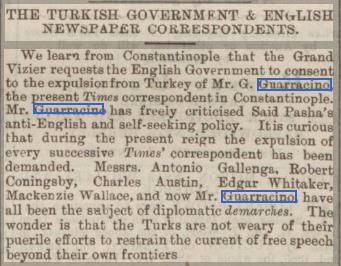
Alongside his career with the Times newspaper, George was appointed manager of the Yalova estate in Constantinople. The Guarracino v. Downes, 1888 court case describes a misunderstanding about the location of the ownership papers of the Yalova Estate. George was taken to court and completely exonerated 92.
George married Evelina Nora Churchill born, 1840 in Constantinople. She was about 14 years younger than him and the daughter of William Nosworthy Churchill, born London 7 November 1796, died 7 September 1846. Her father was founder of the Ceride-i Havadis newspaper. Her mother was Beatrice Belhomme, daughter of a French Merchant.
Final years: George remained living in Constantinople and died in Pera 13th March 1896. His rank or profession on his death certificate is listed as ‘gentleman’ 93.
Third born son, Horace Bronte Luigi Guarracino: born about 1828 Corfu 94. He signed himself Horace Bronte Guarracino. Horace died 24th March 1898, aged 70 years, Galata, Constantinople.
Horace in Constantinople: The first record of Horace in Constantinople is in 1857. Aged 29 years he was involved in a ‘grave affair in Pera High Street’, Constantinople, when he was stabbed by eunuchs 95. It made quite a story and was reported in the British press.
Two months later it was reported that ‘Mr Horace Guarracino’, ‘who our readers may remember being severely wounded in the streets of Constantinople by a eunuch of the Sultan’s household has received £1,000 lire from the Porte 97 as compensation. M, Guarracino has completely recovered, we understand from his wound’ 98.
Horace’s career: Like his brothers, Horace also entered the foreign office and was posted to the ‘near east’ as a consul99. 1860, aged 32 years, he was British Consul-General Moldavia 100. In his role as Consul, Horace had a private conversation with Prince Alexandru Ioan Cuza in Jassy101 102. Horace sent a record of the conversation in an urgent a letter dated 12th April 1860, to the Right Honourable Henry Bulwer, Ambassador extraordinary at Constantinople, 1858-65 103 with a letter enclosed for Henry Churchill, British Consul in Ottoman Syria 104. The letter is a fascinating record of the delicate political alliances and liberal reforms the prince was trying to manage in Moldavia, alongside the relationship with the Ottoman Empire.
In 1876 Horace was a member of a small committee of the Turkish Compassionate Fund in Constantinople, with Consul General Wrench and Henry Hanson. It was overseen by Henry Layard the Ambassador 106. This put him at the heart of the diplomatic community. His name appears often in Lady Layard (the ambassador’s wife diaries), dining or conducting business. On 16 June 1878 — Therapia, Lady Layard wrote:
‘We got home just abt 7.30 in time to dress for dinner. Capt. Wingfield & Capt. McCalmont & Mr Horace Guarracino dined. (The latter slept here) besides the Embassy’ 107.
Horace worked closely with the Ambassador Henry Layard and his wife organising supplies, collecting, distributing relief clothing made by the ladies committee, and preparing and reporting on fund accounts 108.
Horace was also in charge of the Storehouses that had been secured for the fund in the Mehemet Ali Khan in Galata (principally storing materials for clothing made up by the Ladies Committee) 109.
It was noted that Horace’s involvement in the Turkish Compassionate Fund and hard work was of the greatest service:
‘Mr Horace Guarracino, a gentleman, who, throughout the continuance of the Fund, acted as its permanent working superintendent and was of the greatest service’ 110.
1879 Horace was appointed as European Inspector of Turkish Finances in Asia 112.
Cricket in Constantinople: 1874 Horace played for Constantinople Cricket Club (CCC), v ‘The Fleet’ (officers belonging to the Mediterranean Squadron, lying in Bashika Bay) which took place in the Sultans Valley, Beicos. He scored 1 run not out in the second innings 113.
Horace married 11 July 1872, aged 44 years, Marie Clémentine Dupuis (known as Clementine) aged 28 years, Ste Marie Drapéris Roman Catholic Church, Beyoğlu 114. She was born 28th May 1844 in Constantinople. Her birth was registered with the French Consulate. She features in Lady Layard’s diaries as part of her visiting circle of ladies.
‘6 June 1878 — Therapia, Mrs Arthur H. came to call with Mrs H. Guarracino’
The first Dupuis who arrived in Constantinople was Charles Antoine Dupuis born about 1761 in Heilly (Somme) son of a Laurent Dupuis.
Clémentine left Constantinople just before the First World War, moving to Kingston upon Thames with her daughter Edla and family.
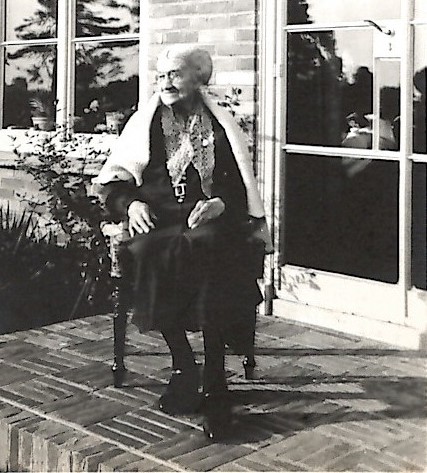
Clementine – family album
Clementine died 12th January 1941 aged 96 years; buried, Our Lady and Saint Edmund Churchyard, Abingdon.
Final years: Horace was living at 8 rue chich-hane, Galata, Constantinople when he died aged 70 years on 24th March 1898 115. At the time he was employed as a Clerk in the Regie Ottoman des Tabacs (also known as Ottoman Regie) Constantinople 116.
Horace is buried in his wife’s ‘Dupuis Famille’ Grave, in the Ferikoy Roman Catholic Cemetery, Istanbul 117. Details in the register give the Italian translation of his name ‘Orazio’ 118. Although Horace was buried in the Catholic Cemetery and his death recorded in a Catholic parish, he was protestant at the time of his marriage 119 (no doubt like his brothers, taking their religion from their mother) 120 121.
Dupuis family grave - Feriköy Latin Catholic Cemetery Istanbul
Fourth born son, Adelbert Henry: known as Henry / Harry, was born about 1845 Kephalonia122. He died, aged 58 years old, on Boxing day, 26 December 1903 123.
1870, aged 25 years, Henry was living in Constantinople along with his mother and three older brothers. Frederick his eldest brother was Acting Consul General at the time.
Henry’s career: Henry was a civil engineer. In 1870 he obtained the contract to build the road from Therapia to Pera 124. The contract came five months after the great fire of Pera, June 5, 1870, which destroyed a large part of the district.
From 1871-73 ‘Enterprise Guarracino’ constructed the first section of the Ottoman Anatolian Railway from Üsküdar to Izmit.
The engineering feat was recorded in a set of photographs taken by Paul Vuccino & Cie, Constantinople 125. Here are two:
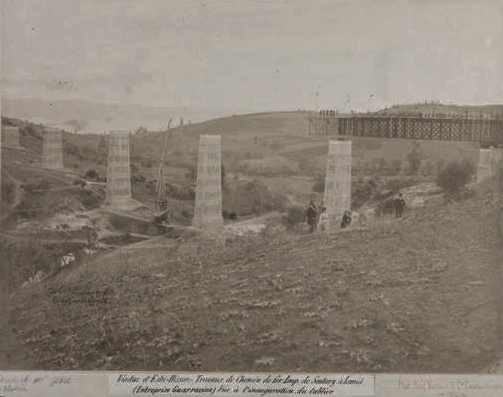
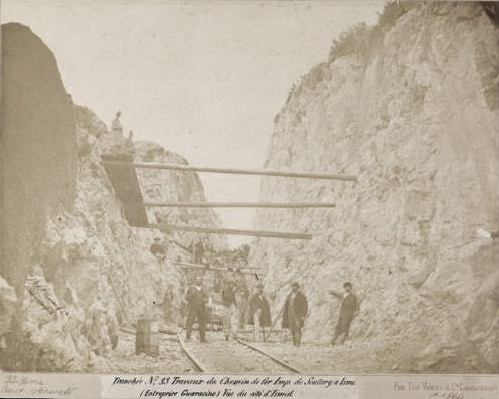
Henry was a partner with his brother George in the Danube and Black Sea Railway Company and the Kustendjie Harbour Co. Ltd 126. The Danube and Black Sea Railway was eventually sold to the Romanian State in 1882. The company’s final dividend was paid in 1884 127. The UK then continued to play a central role in the development and modernisation of the city and port of Constanta 128.
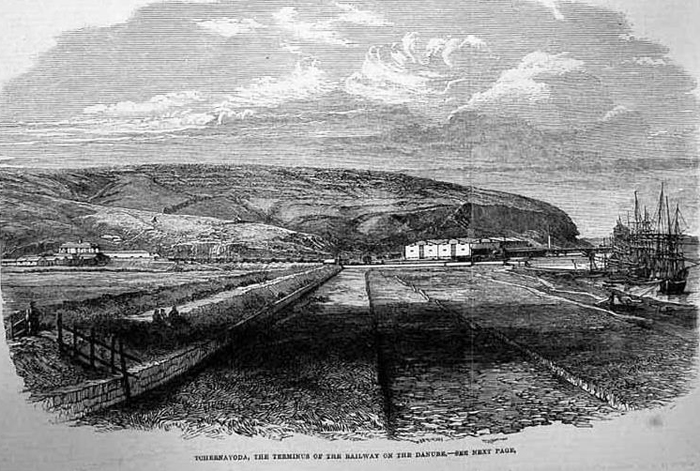
Danube Black Sea Railway Port Kustendjie - Antique print 129.
Henry was still living in Kustendijie at the time of his marriage in 1882. In 1880 the British Vice-Consul’s at Sulina, Kustendjie were, Guarracino, Cumberbatch, Stokes 130. Five years later he moved back to Pera Constantinople 1887 131.
Henry also worked with Charles Francis Tristram, the husband of his niece Mary Tristram (daughter of Horace), who was also a civil engineer. They built or surveyed railways in many countries around the world, including Turkey, Greece, China and Russia 132.
By 1896 Henry had moved to England and was living in Kensington 133. In 1901 Census Henry is recorded as living at 54 Flats, Kensington Mansions Trebovir Rd, Kensington, London with his wife Beatrice, two of her relatives and two servants 134.
Henry was employed by Pauling & Co, 36 Victoria Street, South West London 135. This company was a major British civil engineering contractor renowned chiefly for building railways all over the world. In 1894 they had been contractors for the first 5 miles of the railway of the Syrian Ottoman Company.
In 1900 & 1901 Henry is recorded as a member of the Freemasons attending Drury Lane Lodge 2127 136 137.
Henry aged 36 years married Beartrice Charlotte Crafer born 8 November 1859, Hampton Wick, Kingston 138, on 11th March 1882 at St Marks, Surbiton. She was the youngest daughter of the late Mr Charles Long Crafer a ‘clerk in Holy Orders’ 139 and of Her Majesty’s Treasury 140.
Beatrice was an actress and author. Her stage name was Beatrice Selwin 142. She also wrote a cookery book, published 1903: Please, M’m, the Butcher!’: A Complete Guide to Catering for the Housewife of Moderate Means, 1903 143. Beatrice, died, 16 November 1937 144. She never remarried.
Final years: Henry died very suddenly on 26th December 1903 while away from home at Tyting Farm, St Martha, 26 December 1903.
There was an inquest held into his death on 28 December 1903 by the Coroner for West Sussex, which found he had died of natural causes ‘syncope produced by heart disease’ 146.
Third generation: Grandchildren of Dominico and Isabella
Frederick (first born son) and his wife Ellen, had 6 children. The second and the fourth died in infancy within 4 years 1849-1854. Felix, also born in Samsoon in the same four-year period, died aged 38 years in Constantinople 1891. This must have been a sad time for the family as Felix died two years after his father Frederick and a year before his mother. No further records, church records or GRO Consular records have been found as yet about Felix or the son born in 1862.
- Ellen Guarracino, born 1849 (Malta) 147; died 21 January 1917, 68 years, England 148.
- Caroline Adelaide Isabella Guarracino, born (1849-1854) Samsoon 149; died (1849-1854) Samsoon. 150
- Felix Guarracino, born 1853 Samsoon 151; died, 26 August 1891 Constantinople, aged 38 years. 152
- William Guarracino, born, (1849-1854) Samsoon 153; died; (1849-1854) Samsoon. 154
- Georgiana Evelina Therisina Guarracino, born 20th October 1856 Trebizond 155; died, 28 June 1932, 76 years. Istanbul, Turkey. Buried 29 June 1932 Istanbul Turkey 156. Her mother’s brother Francis Stevens was Consul in Trebizond in 1956, so she must have been visiting him at the time of giving birth to Georgiana. 157
- Birth Announcement of a son - ‘Mrs Guarracino, the wife of Frederick Guarracino, esq HBM Consul, gave birth to a son 11th January 1862 at Khalleppa, near Canea, Crete’. 158
Ellen and Georgiana Guarracino, were the only surviving daughters of Frederick & Ellen.
In 1875, Constantinople, Ellen married Walter (Honourable) Baring, British, (born, 22 October 1844; died on 3 April 1915 at age 70, St George Hanover Square, England)’ 159. This was an advantageous match to a British aristocrat. Ellen and her husband (Mr & Mrs Baring) were very much part of British Diplomatic circle in Constantinople.
Lady Layard the British Ambassadors wife in Constantinople refers to them many times in her diaries, between 22nd April 1877 to 18th May 1879, Constantinople (Pera) and Therapia. Mr and Mrs Baring are dining, or she is going shopping or out visiting with Mrs Baring sometimes in a sedan chair.
‘30 April 1877, At 3 I went out for the 1st time in a sedan chair. I had one which belongs to Lady Eliot. A cavass went before me on foot. I went to Mrs Baring & she also came with me in a chair. We were obliged to go in chairs to pay these visits as carriages cannot get near them. Went to the American Legation & saw Mrs Maynard & to several other places’.
Lady Layard also observed the two Guarracino sisters had a close relationship 160.
‘31 March 1878, Poor Miss Guarracino is very ill of typhus & was prayed for in church. Mrs Baring was there and she was so over-come she had to go away before the sermon’.
Lady Layard also commented on Georgiana the bride who married 19 January 1880, Cathédrale St Esprit Ludwig Johan Seefelder (1838-1907):
‘2 February 1880 — Constantinople I went on to Mme Hobart; met Mme Seefelder the bride there. She was Miss Guarracino. She was dressed wonderfully fine and in a large white felt hat’.
Ludwig Seefelder was a former director of the Haidar Pacha Railway Company 161 and shareholder with his father-in-law in the Souback and Catir Alan Mining Company, Limited’ 162.
George (second born son) and Evelina Nora had 3 daughters:
- Isabella Blanche Guarracino, born 1860-1865 Constantinople 163; married 1st, 24th October 1888 Arthur Herbert Lander, of the Imperial Ottoman Bank at Christ Church Memorial, Constantinople 164 Widowed. Married 2nd, 17 February 1898 Yesilkoy, Istanbul, Ernesto ‘Stefano’ Giulio Bianchi 1857 165. Buried with her father and maternal grandmother in the Guarracino grave, Haidar Pasha Cemetery, Istanbul.
- Ethel Helen, married Alfredo Maria Renato Alberti, (born 18 June 1878 - Smyrne, Izmir, Turkey) 166 in Constantinople, (St Antoine) on June 17, 1909 167.
- Hilda Guarracino, married ‘de Herzfeld’. We know Hilda is George and Nora’s daughter from the family letter she wrote about the origins of the Guarracino’s 168. Searching the name ‘Herzfeld’, revealed on the Levantine Heritage Foundation website, a Maximilian Ritter von Herzfeld, who was an Austrian consul in Constantinople (b. 24th December 1864; d 20 October 1932 Paris) who married Hilda (von Herzfeld) in Paris 169. Hilda in her letter signs herself ‘de Herzfeld’ the ‘de’ being the French equivalent of ‘von’. Given the dates, place and name, this might well be Hilda’s husband?
Horace (third born son) and Clementine, had seven children. The first born died in infancy.
- Emilie Marie Jeanne Guarracino, born 1872 Constantinople; died 1874 aged 2, interred in the Dupuis family grave 170
- Mary Eugenie Guarracino, born, 1874 Constantinople; died 1962 Weybridge, Surrey aged 88; married 11 July 1895 to Charles Joseph Francis Tristram 171 (British) born 1865; (Engineer who worked with Adlebert Henry); died 1933.
- Edla (Adelaide) Isabella Joanna Guarracino, born 1875, Constantinople; died 1950 England, aged 75; married 26 October 1897 to Uvedale Barrington John Baptist Tristram (British) (brother of Charles above) born 1859, (Chief Cashier Imperial Ottoman Bank Constantinople); died 7 April 1926; buried, Kingston Upon Thames, England, aged 66 172
- Alfred Joseph Laurentius Guarracino, born 1877 Constantinople; Commission Agent; died 1943 Marsailles, France, aged 66; married 9 March 1904, Constantinople, to Louise WALDORP
- Marguerite Marie Clémentine Daisy (known as Daisy) born 1878; died 1922 aged 44, Paris; married to Pablo Soler y Guardiola (born 6 July 1865 Madrid, Spain) 173 174; died 1941 Buenos Aires, Argentina, aged 76 years. 175
- Alice Rose Guarracino, born 4 October 1880, Constantinople; died, June 1965, Midhurst, England aged 86 176; married 30 March 1910 to Harry (Henry) Campbell Constantine Vere
- Frederick Joachim Marie Guarracino, born 18 August 1883, Constantinople; Merchant / Commission Agent; died 8 November 1967 Constantinople 177. Interred in the Dupuis family grave along with his second wife Corrine 178; first married, 1st November 1908 in Tokat Turkey, to Anaïs Penelope Savoides, born 1887; died 8th April 1925 (Armenian); 2nd married in 20th May 1925 to Corinne (Corina Maria Giuseppina) Caze 179 (French), born 6 June 1894, (divorcee of George Jean Edmund Badetti. It is said her husband ran off and left her shortly after the birth of their son Silvio); died 16 June 1972, aged 78 years; buried, 19th June in the Dupuis family grave.
Three daughters of Horace and Clementine, Mary, Edla and Alice all married husbands from noted English families. Mary & Edla married two Tristram brothers 180 181. Alice married into the Vere family 182. The sisters (along with their mother, who lived with Edla), left Turkey for England before the First World War in 1914.
Daisy, (Marguerite Marie Clémentine Daisy) married the distinguished Spanish diplomat, Pablo Soler y Guardiola (1865-1941), at one time secretary to the Embassies in Rome and Constantinople; Diplomatic Counsellor in Paris and London and Spanish Ambassador in Argentina and Berlin 183. Members of her family are still settled in Argentina.
Pablo also served as Grand Chamberlain of King Alfonso XIII. It was during that time Daisy was said to be ‘the mistress of King Alfonso X111 of Spain’ 184.
Daisy died very suddenly in Paris from double pneumonia 13 May 1922 185, death announcement appeared in the ABC newspaper on May 16 1922 186:
‘Our ambassador to Berlin, Mr. Soler and Guardiola, went through the horrible bitterness of having suddenly lost his beautiful wife. Mr Soler left his wife in Paris en route to Madrid for business, on Monday of the previous week. At the time the wife of our representative in Berlin had not been inflicted with any illness that would have predicted the dire outcome of her death. Mrs. Soler died of double pneumonia without any medical intervention being able to save her’.
The sons of Horace and Clementine, Alfred and Frederick, were both commission agents. Alfred moved to France with his family to establish his business at some point after 1913 187. Frederick was a commission agent in Istanbul, primarily trading and importing goods from England.
Frederick (known as Freddie) was the only child of Horace and Clementine to remain living in Istanbul throughout his lifetime. He was our mother Maud’s father and our grandfather. On meeting her grandfather aged 12 years, our first cousin Jenny (Maud’s niece) recalls ‘a tall rather formal man, with very kind blue grey eyes’ 188.
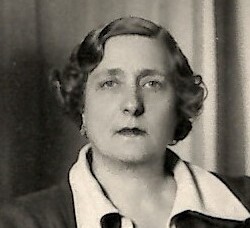
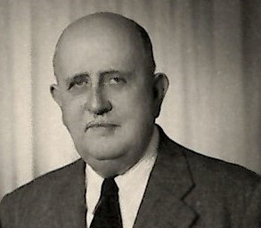
Corrine and Frederick Guarracino – 1950 family album
Frederick’s business and family ties kept him there until he died in 1967. Like his brother and sisters he was a British Subject. He was in Turkey at the start of World War 1 when the Ottoman Empire entered on the side of Germany and were defeated along with them in 1918. This was followed by the Turkish War of Independence which led to the creation of the Turkish republic on October 29, 1923.
Turbulent times
During World War 2, Maud said her mother Corinne was responsible for the efficient running of British Intercept Stations through the British Consulate in Istanbul. She had diplomatic immunity and a chauffeur provided by the Embassy. She received a letter of thanks after the war from the British Government of which she was very proud.
Frederick is buried with his father, second wife Corinne, and infant sister, in the Dupuis family grave in Feriköy Latin Catholic Cemetery 189.
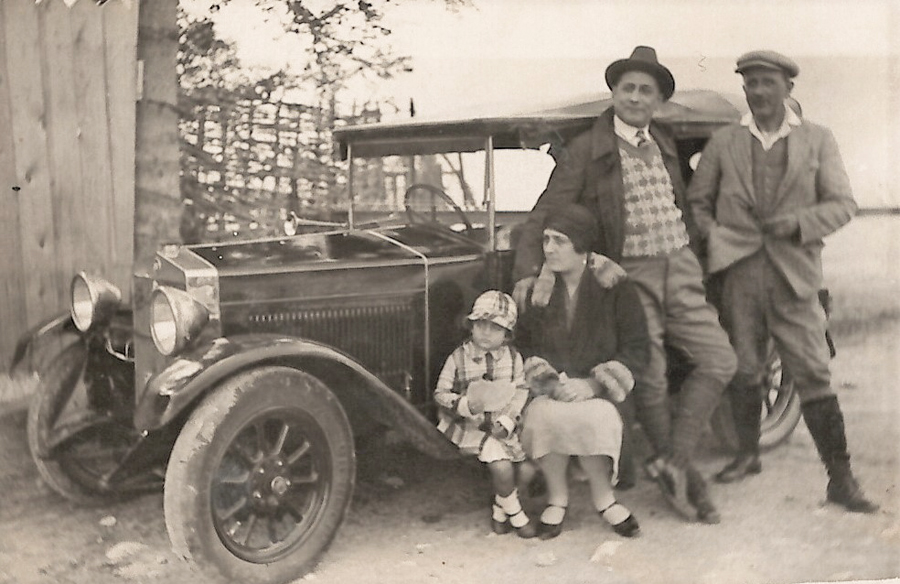
Alfred (left), Frederick (right) standing. Frederick’s wife Corinne sitting with their daughter Maud 5th October 1928 – family album
Fourth Generation: Great grand-children of Dominico and Isabella
Dominico and Isabella had many great grandchildren. They illustrate social fortunes and changing history as many were born in Constantinople / Istanbul, but moved away particularly before the First World War. Through marriage, many of their great grandchildren were of different nationalities; Spanish, French, Italian, German, British, Polish. They were part of the Levantine community of diplomats, bankers, business / trade, engineers.
The lives of several are mentioned below.
Grandchildren of first-born son Frederick and his wife Ellen:
The first grandchild of Frederick and Ellen was born to their daughter Ellen and husband Walter Baring, whilst Isabella was still alive (died, 20 February 1881), and living in Constantinople. She was:
- Nina Ayesha Baring, born, 17 April 1876, Constantinople (died, 12 June 1955, England aged 79). She became an English Duchess, when she married Granville George Leveson-Gower, 3rd Earl Granville on 27 September 1900. As a result of her marriage, Nina was known as the Countess of Granville, with the married name Leveson-Gower. They had no children 190. Nina is mentioned aged 1 year old in Lady Layard’s diaries:
‘19 May 1877, Mrs Baring came to tea. She & her husband & child are come today to stay at Petala’s hotel. Mr Guarracino her father also came & the Davis returned to Pera with him in his fly’ 191.
Another grand-daughter of Frederick and Ellen who obtained a title on marriage was:
- Hilda Maria Luisa Beatrix Seefelder, born 2 May 1884 192. She was Maud’s beloved ‘Cousin Hilda’ whom she speaks of in her memories of Turkey and grandchild of Frederick (first born son), born to his second daughter Georgiana and her husband Ludwig Seefelder.

Countess Hilda Czaikowski nee Seefelder – family album
Hilda, married on Sept 18, 1911 Count Isidore Antoine Stanislas Czaikowski 193, (son of Ladislas Mouzafer Pacha 194 and grandson of Ladislas Czaykowski/Władysław Czajkowski). 195

Count Isidore Czaikowski – family album
Hilda became known at ‘La Countess’. Hilda’s father-in-law Ladislas Mouzafer Pacha also accompanied Sultan Abdülaziz - 32nd Ottoman Emperor, on his European tour, along with George Guarracino her Great Uncle, in the summer of 1876 196. Hilda and her husband left Turkey sometime after 1946, and went to Rome 197 to join her younger sister, Elfrida Seefelder who married 12 July 1905 198 Mario Arlotto 1879-1946 an eminent Italian Diplomat 199.
Grandson of second born son George and his wife Nora:
- Vivian Arthur J Lander (known as Arthur Vivian) born 27 December 1891 Constantinople, to George and Nora’s daughter Isabella and Arthur Lander, made newspaper headlines when he was expelled dramatically from Turkey in 1933 200. The reasons for his expulsion were unclear, but accusations of ‘spying’ may be deduced from his employment as chief agent for the armaments firm Vickers – Armstrongs in Turkey 201. He came to live in London in 1933 and died December 1971 Paddington England 202.
Grandchildren of third born son Horace Bronte and his wife Clementine:
Out of their six living children, Horace Bronte and Clementine had many grand-children. Elizabeth Knight gives full details of the Tristram grandchildren from daughters Mary and Edla in her recollections on the Levantine Heritage Foundation website 204.
Only those of their two sons Alfred and Frederick are mentioned below as they carried on the Guarracino name to their children.
Alfred’s children:
- Henri Clement Herman Guarracino; (Riquet), born, 20 August 1904, Constantinople; died 24.1.1995, in Oloron-Sainte-Marie, Pyrénées-Atlantiques, Nouvelle-Aquitaine (France) 205 was the only male (known) to have carried on the Dominico Guarracino family name to the fifth generation to his son son Jean Claude b.1927 206.
In a letter to his first cousin Maud Guarracino, November 1980, Riquet explained he was a widower aged 76, living in Bois, Goes, France. He moved there as he felt lonely and wanted to be near his ‘dear sister Maddy, also a widower, who lives in the South West of France in a huge and beautiful estate, not very far from Biarritz’ 207.
- Madeleine Sophie Elisabeth Guarracino; (Maddy), Born 19 November 1905; Baptized 24 December 1905 – Constantinople 208, married Raymond Guerlain, of the House of Guerlain perfume.
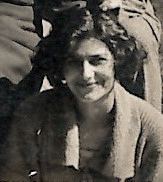
Madeline, 1921 – family album
Frederick was the youngest child of Horace and Clementine and the last to marry and have children born in Turkey after all his siblings left. He had three daughters:
Frederick’s daughter with his first wife Anais was:
- Yvonne Marie Clementine Guarracino, was born 3 Sept 1909 Tokat 209, died 25th November 1978 Surrey, England 210. Married Ronald William Noel Adams 9th September 1939.
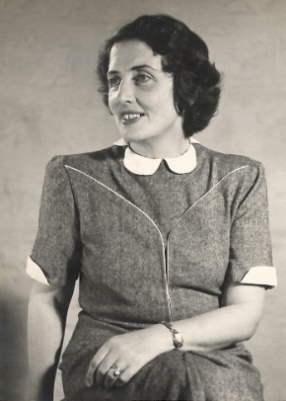
Yvonne – family album
At a young age Yvonne was sent to England to boarding school at Ursuline Convent Wimbledon, England, with whom she attended with some of her first cousins the Tristrams. She boarded during term time and lived with her Aunt Mary (Tristram) during school holidays. Other cousins Melita and Leslie Cumberbatch also stayed with Aunt Mary, with whom Yvonne was very close 211. They were related through Aunt Mary’s husband, whose sister Marian Tristram, married Arthur Cumberbatch 212.
Aged 18 years Yvonne returned to live with her father and his new young family in Istanbul.
Yvonne got a ‘good job’ with the Chamber of Commerce. Her daughter Jenny 213 remembers her mother telling her she enjoyed a rich social life with her many friends from the Levantine community, attending balls, dances, dinner parties, picnics and wonderful boat parties on the Bosphorus and trips with British service personnel who were stationed there. Greeks, Armenians, Jews, Italians, French, British, Russians all lived side by side. There Yvonne met Ronald Adams (b. 27th December 1905; d. 22nd November 1974) when he was teaching at the English High School for boys. She later moved to England where she married Ron 9th September 1939. They lived in England where their two children (Jennifer / Jenny and Stuart) were born, before moving to Kenya for Ron’s work. They returned to Surrey on retirement.
Frederick’s daughters with his second wife Corrinne were:
- Maud (Magdalina) Maria Elvyra Guarracino, (our mother) born, 26th October 1925, Istanbul, Turkey. Baptised 13 December 1925, St Anthony of Padua Church Pera, Istanbul. God parents Alfred Guarracino; Julie Albina and Elvyra Caze; Died 6 April 2013 aged 87 years, Bromsgrove, Worcestershire 214.
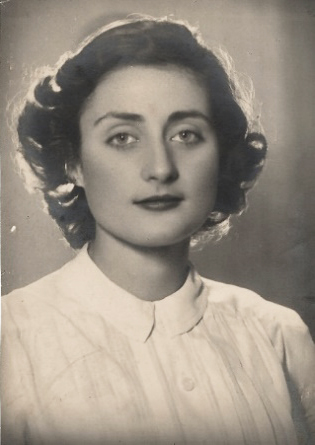
Maud – family album
Growing up, my twin sister Rosemary, brother Michael and I were brought up with our mother’s rich memories of Istanbul and the diverse Levantine community. She attended the English High School for Girls. She left for England in 1946, where she taught in private schools. There she met and married our father on 28th July 1951 William Hagan, a teacher of languages.
In her old age she would speak Greek to herself so she would not lose her fluency. French was her first language so that came naturally.
Prior to coming to England permanently, Maud spent 17 months in England (December 1938 – May 1940) at Queen Mary’s Hospital for children, Carshalton. Her older sister Yvonne who was living in London at the time had urged their father to send Maud privately to England for pioneering treatment, (unavailable in Turkey) for scoliosis. Yvonne took care of her throughout this time and again in 1946 when she first moved to England. Whilst Maud was in hospital Yvonne, Aunt Mary Tristram (her father’s sister) and cousins came to visit her regularly. Her grandmother Clementine wrote to her often and always enclosed sixpence.
In May 1940 Maud was discharged from hospital and caught the Simplon Orient Express back to Istanbul. It was one of the last trains to cross Europe, three weeks before Italy declared war.
- Daisy Guarracino, born 11th October 1929, Istanbul; died 30th December 1999 aged 70 years, Heyrieux, France 215. Buried in Heyrieux cemetery. Married Liem Dang Ngoc (born, circa 1925 died, 14th March 2018).
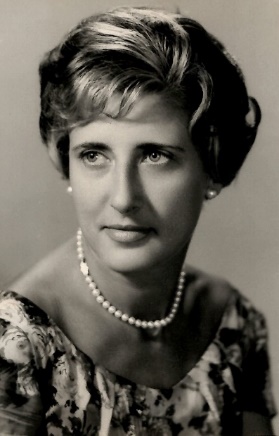
Daisy – family album
Daisy spent her childhood in Istanbul with Maud and Silvio 216. She attended the English Girls High School. She left to come to England in 1950 where she lived in London and worked as a bi lingual secretary. When Daisy became an employee for Shell Oil she went to work in Saigon, (now known as Ho Chi Minh City) and then Vietnam. There she met and married Liem Dang Ngoc. Towards the end of the Vietnam war they moved from Da Nang with their two children Patrick and Claire to France and settled in Heyrieux.
Last links with Turkey
Along with his daughters, Frederick brought up, his second wife Corrine’s son from her first marriage, Silvio Badetti, (born 24 August 1918), 217 as his own, from a young age. He was a much-loved member of the Guarracino family. He stayed in Istanbul and supported Corinne and Frederick in their old age.
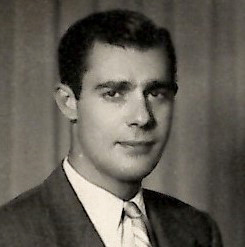
Silvio – family album
Silvio inherited Frederick Guarracino’s business as a Commission Agent. He maintained his sister’s links to the Levantine community in Istanbul and steered the family business through turbulent political times. He often travelled to England for business before finally retiring in the early 1980’s when he moved to Heyrieux, France to be near Daisy. Silvio married, 27 December 1952, Anna Cehélovitch. They had no children. He died, 26 July 1995, Heyrieux.
The Guarracino (& Sutor) family history reflects the growing British influence in the Mediterranean following the Napoleonic wars and the move from West to East through Malta, Ionian Islands into Turkey. The Guarracino’s were a part of the British contribution to the growth and development of Turkey through diplomacy, politics, trade and railways. Any trace of them in Istanbul has now gone except for those left behind in the cemeteries and records.
Many thanks to Craig Encer for encouraging me (over many years) to write up this research and mother’s memories so they too will not be lost. Please do not reproduce without seeking permission.

